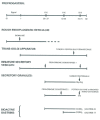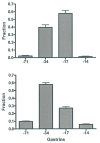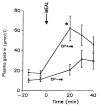Gastrin and the Moderate Hypergastrinemias
- PMID: 34209478
- PMCID: PMC8269006
- DOI: 10.3390/ijms22136977
Gastrin and the Moderate Hypergastrinemias
Abstract
The antral hormone gastrin potently regulates gastric acid secretion and fundic mucosal growth. Consequently, appropriate gastrin secretion and plasma concentrations are important for the early phases of digestion. This review describes as the first premise the normal biogenesis of gastrin in the antral mucosa, but also mentions the extraantral expression. Subsequently, the molecular nature and concentration levels of gastrin in serum or plasma are overviewed. Third, assays for accurate measurements of plasma or serum concentrations are commented. Finally, the problem of moderate hypergastrinemia due to Helicobacter pylori infections and/or treatment with proton-pump inhibitors (PPI) is discussed. The review concludes that accurate measurement of the true concentrations of bioactive gastrins in plasma is important. Moreover, it suggests that moderate hypergastrinemias are also essential health issues that require serious attention.
Keywords: Helicobacter pylori; duodenal ulcer; gastric cancer; gastrin; hypergastrinemia; proton-pump inhibitors.
Conflict of interest statement
The author declares no conflict of interest.
Figures





Similar articles
-
Implication of gastrin in cyclooxygenase-2 expression in Helicobacter pylori infected gastric ulceration.Prostaglandins Other Lipid Mediat. 2001 Aug;66(1):39-51. doi: 10.1016/s0090-6980(01)00142-3. Prostaglandins Other Lipid Mediat. 2001. PMID: 11519793
-
Effect of Helicobacter pylori infection on antral gastrin and somatostatin cells and on serum gastrin concentrations.Korean J Intern Med. 1999 Jan;14(1):15-20. doi: 10.3904/kjim.1999.14.1.15. Korean J Intern Med. 1999. PMID: 10063309 Free PMC article.
-
Old and New Gut Hormone, Gastrin and Acid Suppressive Therapy.Digestion. 2018;97(4):340-344. doi: 10.1159/000485734. Epub 2018 Mar 27. Digestion. 2018. PMID: 29587283 Review.
-
Mucosal gastrin cells and serum gastrin levels in children with Helicobacter pylori infection.Adv Med Sci. 2006;51:137-41. Adv Med Sci. 2006. PMID: 17357294
-
Gastric cancer and gastrin: on the interaction of Helicobacter pylori gastritis and acid inhibitory induced hypergastrinemia.Scand J Gastroenterol. 2019 Sep;54(9):1118-1123. doi: 10.1080/00365521.2019.1663446. Epub 2019 Sep 14. Scand J Gastroenterol. 2019. PMID: 31524029 Review.
Cited by
-
The central role of gastrin in gastric cancer.Front Oncol. 2023 Oct 24;13:1176673. doi: 10.3389/fonc.2023.1176673. eCollection 2023. Front Oncol. 2023. PMID: 37941554 Free PMC article. Review.
-
Experience in diagnosis and treatment of duodenal ulcer perforation in children.BMC Pediatr. 2023 Mar 30;23(1):144. doi: 10.1186/s12887-023-03957-8. BMC Pediatr. 2023. PMID: 36997985 Free PMC article.
-
The Gastric Connection: Serum Gastric Biomarkers, Metabolic Syndrome and Transition in Metabolic Status.J Inflamm Res. 2024 Sep 16;17:6439-6452. doi: 10.2147/JIR.S475352. eCollection 2024. J Inflamm Res. 2024. PMID: 39310898 Free PMC article.
-
Autoimmune Gastritis and Hypochlorhydria: Known Concepts from a New Perspective.Int J Mol Sci. 2024 Jun 21;25(13):6818. doi: 10.3390/ijms25136818. Int J Mol Sci. 2024. PMID: 38999928 Free PMC article. Review.
-
A Comparative Study on the Distribution Pattern of Endocrine Cells in the Gastrointestinal Tract of Two Small Alpine Mammals, Plateau Zokor (Eospalax baileyi) and Plateau Pika (Ochotona curzoniae).Animals (Basel). 2023 Feb 12;13(4):640. doi: 10.3390/ani13040640. Animals (Basel). 2023. PMID: 36830427 Free PMC article.
References
-
- Schubert M.L., Rehfeld J.F. Gastric peptides—Gastrin and somatostatin. Compr. Physiol. 2020;10:197–228. - PubMed
Publication types
MeSH terms
Substances
LinkOut - more resources
Full Text Sources

